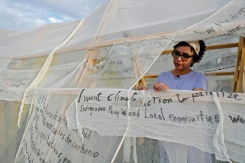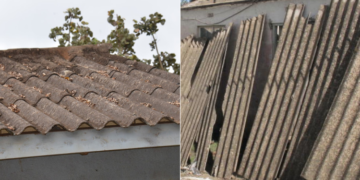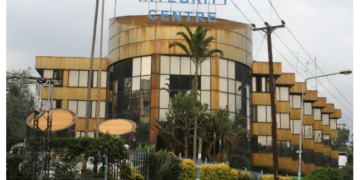Egyptian artist Bahia Shehab had one goal at the COP27 climate talks in Egypt: to let people experience the “hell” that is global warming.
At first, she said, she wanted to “hack the rooms” to turn up the heat on delegates from two hundred countries who have been talking for two weeks about how to drive forward action against worsening climate change.
With wealthy and developing nations struggling to agree on final deals, talks were extended to Saturday.
“There’s research that said that people who are in a hotter place, in a hotter room, they’re more likely to believe in climate change than those who are not,” Shehab said at Egypt’s Red Sea resort city of Sharm el-Sheikh, which is hosting the talks.
But due to security measures, instead of the “hack”, Shehab set up a public art installation dubbed “Heaven and Hell in the Anthropocene”.
It features two adjacent rooms, one heated at 45 degrees Celsius (113 Fahrenheit) while the other is air-conditioned.

“We wanted to come up with a scenario that is accessible to everyone,” she said.
Campaigners the world over have been pulling public stunts targeting artworks to draw attention to global inaction over climate change.
In Milan on Friday, climate activists threw flour over a car repainted by American artist Andy Warhol.
“Do we really get outraged at the simulation of damage to works of art while the ongoing objective destruction of works of nature, ecosystems and our own lives leaves us indifferent?” the activists from the Last Generation group wrote in a statement.
Activists have also glued themselves to a Francisco Goya painting in Madrid, thrown soup at Vincent van Goghs in London and Rome, and mashed potatoes on a Claude Monet in Germany.
Triggering questions
Shehab has taken a more restrained approach with her art and says it works, producing an impact on many.

“Scary,” a British visitor who gave her name as Jolene said of the “hell” room, in contrast with the “cool, clean, nice” environment she found in heaven.
The artist said she had already seen attitudes change.
“There’s one girl who walked out of ‘hell’ who said: ‘I will never throw trash on the ground ever again,'” she said.
“So, to me, it’s not important whether they like it aesthetically or not but it’s really important that it triggers questions and that they reconsider their daily practice.”
Another artist, rehab El-Sadek, sought to be the voice of indigenous populations across Egypt. She pitched a Bedouin-like tent inscribed with messages in Arabic, English and Spanish.

“I want climate action to priorities indigenous and local communities,” one message read.
Sadek said that, with the COP taking place in the Sinai Peninsula, home to nomadic Bedouin, “we thought that the tent… will make a connection between locals and people around the world.”
Indian artist Shilo Shiv Suleman painted an entire mural at the COP27 complex to send a message “to the leaders of the world who consider the planet as a product”.
The mural depicting animals in their natural habitat is a reminder “to return to ourselves the mountains, the stars, the rivers and ways of being that placed us within the empire of the earth, not outside of it,” she said.
But art’s role is not limited to raising awareness, said Marguerite Courtel, a Paris-based expert on environmental transition and culture.
It should also develop techniques to fend off the impact of climate change, and she said a key question remains: Are the works themselves produced with “eco-responsibility”?
















































































